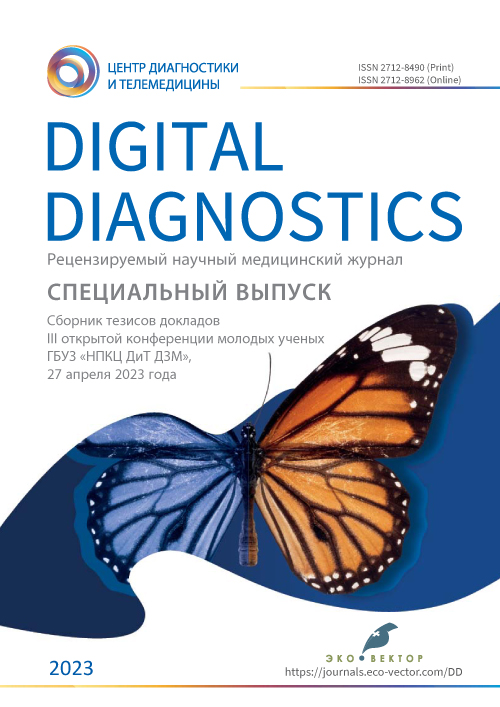Three-dimensional reconstruction of the pelvic bones on MRI scans
- Authors: Ikryannikov E.O.1
-
Affiliations:
- Research and Practical Clinical Center for Diagnostics and Telemedicine Technologies
- Issue: Vol 4, No 1S (2023)
- Pages: 60-61
- Section: Conference proceedings
- Submitted: 18.05.2023
- Accepted: 18.05.2023
- Published: 26.06.2023
- URL: https://jdigitaldiagnostics.com/DD/article/view/430345
- DOI: https://doi.org/10.17816/DD430345
- ID: 430345
Cite item
Full Text
Abstract
BACKGROUND: Pelvimetry is an important part of the obstetric examination for predicting a mismatch between the size of the fetus and the mother’s pelvis, which leads to difficulty or impossibility of vaginal delivery. Contracted pelvis is one of the main causes of maternal birth trauma and perinatal morbidity and mortality.
AIM: To create a computer vision model for automatic segmentation and three-dimensional (3D) reconstruction of the pelvic bones.
METHODS: A 3D U-Net-based neural network was used and trained on T2 weighted images in frontal projection (repetition time, 7500; echo time, 130; slice thickness, 4mm; field-of-view, 40×39; matrix, 256×256). The sample size covered 49 patients. The training and test samples included 42 and 7 examinations, respectively. The segmentation of areas of interest was done manually and verified by a specialist. The sample size was justified by achieving representativeness of the data for obtaining a qualitative model (according to the Sorensen–Dice coefficient).
RESULTS: 3D reconstructions of the pelvic bones were obtained. The average Sorensen-Dice coefficient on the accuracy of pelvic bone segmentation in the test sample was 0.86. The result justified the use of a 3D U-Net-based neural network as a tool capable of perceiving a 3D structure of images and conducting qualitative segmentation. The results allow further work on automating the determination of key points at reconstructions.
CONCLUSIONS: A computer vision model for automatic segmentation of the pelvic bones to obtain 3D reconstruction of images was created. This enabled the next stage of the study, i.e. the development of a model for determining the key points in the images and the distances between the points.
Keywords
Full Text
BACKGROUND: Pelvimetry is an important part of the obstetric examination for predicting a mismatch between the size of the fetus and the mother’s pelvis, which leads to difficulty or impossibility of vaginal delivery. Contracted pelvis is one of the main causes of maternal birth trauma and perinatal morbidity and mortality.
AIM: To create a computer vision model for automatic segmentation and three-dimensional (3D) reconstruction of the pelvic bones.
METHODS: A 3D U-Net-based neural network was used and trained on T2 weighted images in frontal projection (repetition time, 7500; echo time, 130; slice thickness, 4mm; field-of-view, 40×39; matrix, 256×256). The sample size covered 49 patients. The training and test samples included 42 and 7 examinations, respectively. The segmentation of areas of interest was done manually and verified by a specialist. The sample size was justified by achieving representativeness of the data for obtaining a qualitative model (according to the Sorensen–Dice coefficient).
RESULTS: 3D reconstructions of the pelvic bones were obtained. The average Sorensen-Dice coefficient on the accuracy of pelvic bone segmentation in the test sample was 0.86. The result justified the use of a 3D U-Net-based neural network as a tool capable of perceiving a 3D structure of images and conducting qualitative segmentation. The results allow further work on automating the determination of key points at reconstructions.
CONCLUSIONS: A computer vision model for automatic segmentation of the pelvic bones to obtain 3D reconstruction of images was created. This enabled the next stage of the study, i.e. the development of a model for determining the key points in the images and the distances between the points.
About the authors
Egor O. Ikryannikov
Research and Practical Clinical Center for Diagnostics and Telemedicine Technologies
Author for correspondence.
Email: ikriannikove01@gmail.com
ORCID iD: 0000-0002-1780-6903
Russian Federation, Moscow
References
- Ternovoi SK, Volobuev AI, Kurinov SB, Panov VO, Shariya MA. Magnitno-rezonansnaya pel’viometriya. Meditsinskaya vizualizatsiya. 2001;(4):6–12. (In Russ).
- Woo B, Lee M. Comparison of tissue segmentation performance between 2D U-Net and 3D U-Net on brain MR Images. In: 2021 International Conference on Electronics, Information, and Communication (ICEIC). IEEE; 2021. P. 1–4.
Supplementary files















